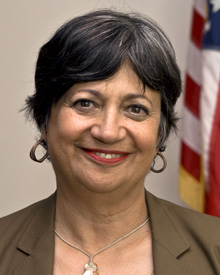
The state of California releases its proposal for reducing tailpipe emissions for 2017-2025, a program closely following formalized national rules revealed Wednesday but one that puts a greater onus on auto makers to sell more zero-emissions vehicles.
“This package assures the development of environmentally superior cars that will continue to deliver the performance, utility and safety vehicle owners have come to expect,” California Air Resources Board Chairman Mary Nichols says in a statement accompanying the proposed rules.

See the CARB Advanced Clean Cars Summary
A fuller breakdown of the rules and additional related data will come from California on Dec. 7. The state hopes to enact the laws in January.
CARB says the proposed rule meets the U.S. auto makers’ desire for “a single national program within California’s separate motor vehicle emissions control program” and is “designed to parallel the national greenhouse-gas and fuel-economy standards.”
The standard released Wednesday by the U.S. National Highway Traffic Safety Admin. and Environmental Protection Agency calls for auto makers to achieve a fleet-fuel economy of 54.5 mpg (4.3 L/100 km) by 2025, or roughly twice the efficiency of the current standard.
The fuel-economy target would equate to carbon-dioxide emissions of 163 g/pm.
CARB sets a 2025 emissions target of 166 g/m, slightly looser than the national standard to account for a state fleet leaning more toward larger vehicles than that of the rest of the nation. It nonetheless would reduce tailpipe emissions in California by 47%, compared with current levels of about 315 g/m.
However, the California rules will demand more zero-emissions vehicles from auto makers. The state wants one of every seven vehicles sold there by 2025 to be a ZEV or plug-in hybrid electric vehicle. That’s roughly 15.4% of the vehicles sold in the state annually and up from less than 1% today.
NHTSA and EPA estimates for the 2017-2025 rulemaking anticipate ZEVs to account for up to 15% of the sales mix, but that figure includes strong hybrids and California does not. Strong hybrids include vehicles such as the Toyota Prius and General Motors hybrid trucks and SUVs.
California wants 1.4 million ZEVs on its roads by 2025, with 500,000 of those battery-electric or fuel-cell vehicles. As of 2009, the state was home to 32.8 million registered light vehicles, according to WardsAuto data.
As a way to get auto makers to focus more on ZEVs, CARB also proposes eliminating the partial-zero-emissions vehicle and advanced-technology partial-zero-emissions vehicle credits as a compliance option for auto makers, because those technologies are now commercialized.
AT PZEV and PZEV models include hybrids, compressed-natural-gas and conventional gasoline vehicles.
CARB’s rulemaking for 2025 also would increase the number of large-volume vehicle producers selling in the state, which would bring more OEMs under its ZEV regulations. That means Hyundai, Kia, BMW, Mazda, Volkswagen and Daimler would join the likes of General Motors, Ford and Toyota in being required to meet ZEV targets.
CARB also will toughen what it calls a “travel rule.” Previously, an auto maker could count a ZEV sold in another state as a sale in California. That provision would end in 2017 but would continue to include fuel-cell vehicles to encourage their deployment nationwide.
CARB expects the average price of a vehicle to increase by $1,900 because of the additional technology necessary to meet its standards. Some groups have estimated the cost of a vehicle to jump as much as $3,000 due to the national standard.





